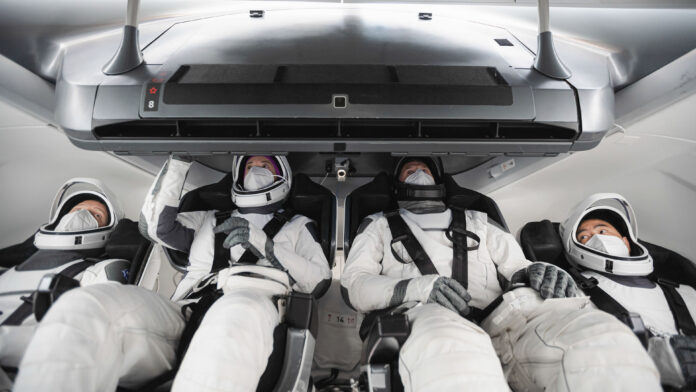
WASHINGTON, D.C. – NASA and SpaceX are continuing a regular cadence of missions with astronauts launching on an American rocket from American soil to the International Space Station as part of NASA’s Commercial Crew Program. NASA’s SpaceX Crew-2 is the second crew rotation mission with four astronauts flying on a commercial spacecraft, and the first with two international partner astronauts.
NASA’s SpaceX Crew-2 mission will carry astronauts Shane Kimbrough and Megan McArthur of NASA, Akihiko Hoshide of JAXA (Japan Aerospace Exploration Agency), and ESA (European Space Agency) astronaut Thomas Pesquet aboard a Crew Dragon spacecraft launching atop a Falcon 9 rocket on its way to the space station. The mission is scheduled to lift off no earlier than April 20 from Launch Complex 39A at NASA’s Kennedy Space Center in Florida.
The crew is scheduled for a long-duration stay aboard the orbiting laboratory, spending several months conducting science and maintenance before the four astronauts return to Earth in fall 2021.
NASA’s SpaceX Demo-2 test flight completed in 2020 was the final demonstration flight of the Crew Dragon and was followed by NASA completing the certification of the Crew Dragon system ahead of the Crew-1 mission.
All four astronauts were assigned to the Crew-2 mission in July 2020 and began working and training on SpaceX’s next-generation human spacecraft and for their long-duration stay aboard the space station.
Shane Kimbrough is commander of the Crew Dragon spacecraft and the Crew-2 mission. Kimbrough is responsible for all phases of flight, from launch to re-entry. He also will serve as an Expedition 65 flight engineer aboard the station. Selected as a NASA astronaut in 2004, Kimbrough first launched aboard space shuttle Endeavour for a visit to the station on the STS-126 mission in 2008, then aboard a Russian Soyuz spacecraft for his first long-duration mission for Expedition 49/50 in 2016. He has spent a total of 189 days in space and performed six spacewalks. Kimbrough also is a retired U.S. Army colonel and earned a bachelor’s degree in aerospace engineering from the United States Military Academy at West Point, New York, and a master’s degree in operations research from the Georgia Institute of Technology in Atlanta.
Megan McArthur is the pilot of the Crew Dragon spacecraft and second-in-command for the mission. McArthur is responsible for spacecraft systems and performance. She also will be a long-duration space station crew member, making her first trip to the space station. Selected as an astronaut in 2000, McArthur launched on space shuttle Atlantis as a mission specialist on STS-125, the final Hubble Space Telescope servicing mission, in 2009. McArthur operated the shuttle’s robotic arm over the course of the 12 days, 21 hours she spent in space, capturing the telescope and moving crew members during the five spacewalks needed to repair and upgrade it. She holds a bachelor’s degree in aerospace engineering from the University of California, Los Angeles, and a doctorate in oceanography from the University of California, San Diego.
Akihiko Hoshide is a mission specialist for Crew-2. As a mission specialist, he will work closely with the commander and pilot to monitor the spacecraft during the dynamic launch and re-entry phases of flight. Once aboard the station, Hoshide will become a flight engineer for Expedition 65. Hoshide joined the National Space Development Agency of Japan (NASDA, currently JAXA) in 1992 and was selected as an astronaut candidate in February 1999. Hoshide is a veteran of two spaceflights. In June 2008, he flew to the International Space Station on the STS-124 mission to deliver the Japanese Experiment Module “Kibo” to the station. From July to November 2012, he stayed on the space station for 124 days as a flight engineer for the Expedition 32/33 mission. The Crew Dragon will be the third spacecraft that Noguchi has flown to the orbiting laboratory.
Thomas Pesquet will also be a mission specialist for Crew-2, working with the commander and pilot to monitor the spacecraft during the dynamic launch and re-entry phases of flight. Pesquet also will become a long-duration crew member aboard the space station. He was selected as an astronaut candidate by ESA in May 2009 and worked as a Eurocom, communicating with astronauts during spaceflights from the mission control center. He previously flew as part of Expeditions 50 and 51, launching aboard a Russian Soyuz spacecraft and spending 196 days in space. His mission also included two spacewalks to maintain the station: one to replace batteries on an electrical channel, and one to fix a cooling leak and service the robotic arm.
Lifting off from Launch Pad 39A on a Falcon 9 rocket, Crew Dragon will accelerate its four passengers to approximately 17,500 mph and put it on an intercept course with the International Space Station. The Falcon 9 that will be used to launch this mission uses the same booster as NASA’s SpaceX Crew-1, marking the first time a flight-proven booster will be used for a crewed launch.
Once in orbit, the crew and SpaceX mission control will monitor a series of automatic maneuvers that will guide the Crew-2 astronauts to their new home in orbit. After a predetermined time in orbit driven by the launch date, Crew Dragon will be in position to rendezvous and dock with the space station. The spacecraft is designed to dock autonomously with the ability for astronauts aboard the spacecraft to take control and pilot manually, if necessary.
After successfully docking, the astronauts of Crew-2 will be welcomed aboard station by the Expedition 65 crew, including the Crew-1 astronauts still onboard. The space station’s crew size will again expand to seven people, increasing the amount of crew time available for research.
The Crew Dragon being used for this flight will remain docked to the station for the full length of a long-duration space station expedition, lasting approximately six months. It is the same Crew Dragon capsule, dubbed “Endeavour,” that astronauts Douglas Hurley and Robert Behnken flew to the space station for their historic Demo-2 mission. The Crew-2 astronauts will spend their time aboard the International Space Station conducting new and exciting scientific research in areas, such as medical technology, human health, and materials to benefit life on Earth.
Crew members will test the Butterfly IQ Ultrasound, a portable ultrasound device used in conjunction with a mobile computing device in the space environment. They also will conduct a variety of tissue engineering investigations, ranging from studies of bone, cardiovascular, muscle and liver health. An experiment from retail store Target will study cotton growth in microgravity to help identify more robust cotton varieties that require less water and pesticide use.
During their stay on the orbiting laboratory, astronauts of Crew-2 will see cargo spacecraft including the Northrop Grumman Cygnus and the SpaceX cargo Dragon. They will conduct a series of spacewalks to install new solar arrays, increasing the station’s total available power from 160 kilowatts to up to 215 kilowatts.
At the conclusion of the mission, Crew Dragon will autonomously undock with the four astronauts on board, depart the space station and re-enter the Earth’s atmosphere. After splashdown just off Florida’s coast, a SpaceX recovery vessel will pick up the crew and bring them back to shore to board a plane for return to NASA’s Johnson Space Center in Houston.
The Crew-2 mission continues the efforts of NASA’s Commercial Crew Program to restore and maintain American leadership in human spaceflight. Regular, long-duration commercial crew rotation missions enable NASA to continue the important research and technology investigations taking place onboard the station. Such research benefits people on Earth and lays the groundwork for future exploration of the Moon and Mars starting with the agency’s Artemis program, which will land the first woman and the next man on the lunar surface.




















